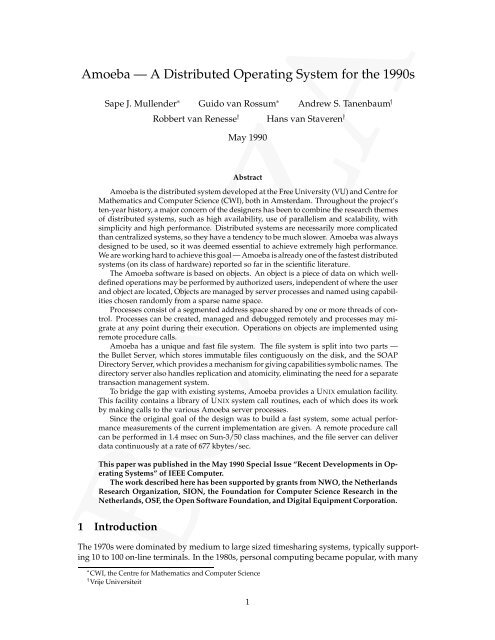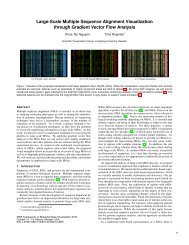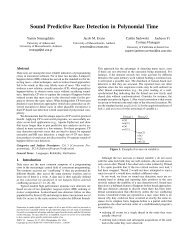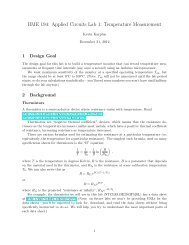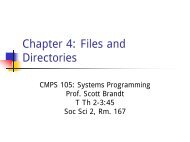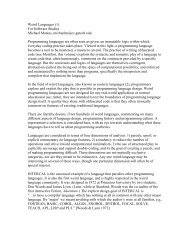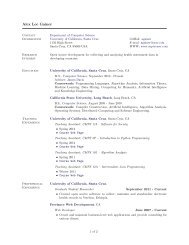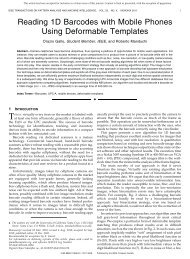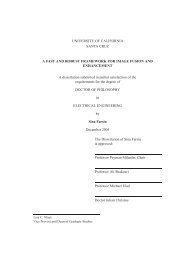Amoeba — A Distributed Operating System for the 1990s - CiteSeerX
Amoeba — A Distributed Operating System for the 1990s - CiteSeerX
Amoeba — A Distributed Operating System for the 1990s - CiteSeerX
Create successful ePaper yourself
Turn your PDF publications into a flip-book with our unique Google optimized e-Paper software.
<strong>Amoeba</strong> <strong>—</strong> A <strong>Distributed</strong> <strong>Operating</strong> <strong>System</strong> <strong>for</strong> <strong>the</strong> <strong>1990s</strong><br />
Sape J. Mullender Guido van Rossum Andrew S. Tanenbaum y<br />
Robbert van Renesse y<br />
May 1990<br />
Abstract<br />
Hans van Staveren y<br />
<strong>Amoeba</strong> is <strong>the</strong> distributed system developed at <strong>the</strong> Free University (VU) and Centre <strong>for</strong><br />
Ma<strong>the</strong>matics and Computer Science (CWI), both in Amsterdam. Throughout <strong>the</strong> project’s<br />
ten-year history, a major concern of <strong>the</strong> designers has been to combine <strong>the</strong> research <strong>the</strong>mes<br />
of distributed systems, such as high availability, use of parallelism and scalability, with<br />
simplicity and high per<strong>for</strong>mance. <strong>Distributed</strong> systems are necessarily more complicated<br />
than centralized systems, so <strong>the</strong>y have a tendency to be much slower. <strong>Amoeba</strong> was always<br />
designed to be used, so it was deemed essential to achieve extremely high per<strong>for</strong>mance.<br />
We are working hard to achieve this goal <strong>—</strong> <strong>Amoeba</strong> is already one of <strong>the</strong> fastest distributed<br />
systems (on its class of hardware) reported so far in <strong>the</strong> scientific literature.<br />
The <strong>Amoeba</strong> software is based on objects. An object is a piece of data on which welldefined<br />
operations may be per<strong>for</strong>med by authorized users, independent of where <strong>the</strong> user<br />
and object are located, Objects are managed by server processes and named using capabilities<br />
chosen randomly from a sparse name space.<br />
Processes consist of a segmented address space shared by one or more threads of control.<br />
Processes can be created, managed and debugged remotely and processes may migrate<br />
at any point during <strong>the</strong>ir execution. Operations on objects are implemented using<br />
remote procedure calls.<br />
<strong>Amoeba</strong> has a unique and fast file system. The file system is split into two parts <strong>—</strong><br />
<strong>the</strong> Bullet Server, which stores immutable files contiguously on <strong>the</strong> disk, and <strong>the</strong> SOAP<br />
Directory Server, which provides a mechanism <strong>for</strong> giving capabilities symbolic names. The<br />
directory server also handles replication and atomicity, eliminating <strong>the</strong> need <strong>for</strong> a separate<br />
transaction management system.<br />
To bridge <strong>the</strong> gap with existing systems, <strong>Amoeba</strong> provides a UNIX emulation facility.<br />
This facility contains a library of UNIX system call routines, each of which does its work<br />
by making calls to <strong>the</strong> various <strong>Amoeba</strong> server processes.<br />
Since <strong>the</strong> original goal of <strong>the</strong> design was to build a fast system, some actual per<strong>for</strong>mance<br />
measurements of <strong>the</strong> current implementation are given. A remote procedure call<br />
can be per<strong>for</strong>med in 1.4 msec on Sun-3/50 class machines, and <strong>the</strong> file server can deliver<br />
data continuously at a rate of 677 kbytes/sec.<br />
This paper was published in <strong>the</strong> May 1990 Special Issue “Recent Developments in <strong>Operating</strong><br />
<strong>System</strong>s” of IEEE Computer.<br />
The work described here has been supported by grants from NWO, <strong>the</strong> Ne<strong>the</strong>rlands<br />
Research Organization, SION, <strong>the</strong> Foundation <strong>for</strong> Computer Science Research in <strong>the</strong><br />
Ne<strong>the</strong>rlands, OSF, <strong>the</strong> Open Software Foundation, and Digital Equipment Corporation.<br />
1 Introduction<br />
BOZZA<br />
The 1970s were dominated by medium to large sized timesharing systems, typically supporting<br />
10 to 100 on-line terminals. In <strong>the</strong> 1980s, personal computing became popular, with many<br />
<br />
CWI, <strong>the</strong> Centre <strong>for</strong> Ma<strong>the</strong>matics and Computer Science<br />
y<br />
Vrije Universiteit<br />
1
organizations installing large numbers of PCs and engineering workstations, usually connected<br />
by a fast local area network. In <strong>the</strong> <strong>1990s</strong>, computer prices will drop so low that it will be economically<br />
feasible to have 10, 20, or perhaps 100 powerful microprocessors per user. The key<br />
issue is how to organize all this computing power in a simple, efficient, fault-tolerant, and especially,<br />
easy to use way. In this paper we describe a distributed operating system that meets<br />
this challenge.<br />
The basic problem with current networks of PCs and workstations is that <strong>the</strong>y are not transparent,<br />
that is, <strong>the</strong> users are clearly conscious of <strong>the</strong> existence of multiple machines. One logs<br />
into a specific machine and uses that machine only, until one does a remote login to ano<strong>the</strong>r<br />
machine. Few, if any, programs can take advantage of multiple CPUs, even if <strong>the</strong>y are all idle,<br />
<strong>for</strong> example. An operating system <strong>for</strong> connecting up a number of autonomous computers is<br />
usually called a network operating system.<br />
In contrast, <strong>the</strong> kind of system we envision <strong>for</strong> <strong>the</strong> <strong>1990s</strong> appears to <strong>the</strong> users as a single,<br />
1970s centralized timesharing system. Users of this system are not aware of which processors<br />
<strong>the</strong>ir jobs are using (or even how many), <strong>the</strong>y are not aware of where <strong>the</strong>ir files are stored (or<br />
how many replicated copies are being maintained to provide fault tolerance) or how communication<br />
is taking place among <strong>the</strong> processes and machines. The whole thing just looks like a<br />
single big timesharing system. All <strong>the</strong> resource management is done completely automatically<br />
by what is called a distributed operating system.<br />
Few such systems have been designed, and even fewer have been implemented. Fewer<br />
still, are actually used by anyone (yet). One of <strong>the</strong> earliest distributed systems was <strong>the</strong> Cambridge<br />
<strong>Distributed</strong> Computing <strong>System</strong> [Needham and Herbert, 1982]. Later, o<strong>the</strong>r systems<br />
were developed, such as Locus [Walker et al., 1983], Mach [Accetta et al., 1986] V-Kernel [Cheriton,<br />
1988], and Chorus [Rozier et al., 1988]. Most of <strong>the</strong> classical distributed systems literature,<br />
however, describes work on parts of, or aspects of distributed systems. There are many papers<br />
on distributed file servers, distributed name servers, distributed transaction systems, and so<br />
on, but <strong>the</strong>re are few on whole systems.<br />
In this paper we will describe a research project <strong>—</strong> <strong>Amoeba</strong> <strong>—</strong> that has successfully constructed<br />
a working prototype system. We will cover most of <strong>the</strong> traditional operating system<br />
design issues, including communication, protection, <strong>the</strong> file system, and process management.<br />
We will not only explain what we did, but also why we did it.<br />
2 Overview of <strong>Amoeba</strong><br />
The <strong>Amoeba</strong> Project [Mullender and Tanenbaum, 1986] is a joint ef<strong>for</strong>t of groups at <strong>the</strong> Free<br />
University (VU), and <strong>the</strong> Centre <strong>for</strong> Ma<strong>the</strong>matics and Computer Science (CWI), both in Amsterdam.<br />
The VU group is led by Andrew S. Tanenbaum, <strong>the</strong> CWI group by Sape J. Mullender.<br />
The project has been underway now <strong>for</strong> nearly ten years and has gone through numerous<br />
redesigns and reimplementations as design flaws became glaringly apparent. This paper describes<br />
<strong>the</strong> <strong>Amoeba</strong> 4.0 system, which was released in 1990.<br />
2.1 The <strong>Amoeba</strong> Hardware Architecture<br />
The <strong>Amoeba</strong> hardware architecture is shown in Figure 1. It consists of four components: workstations,<br />
pool processors, specialized servers, and gateways. The workstations are intended<br />
to execute only processes that interact intensively with <strong>the</strong> user. The window manager, <strong>the</strong><br />
command interpreter, editors, CAD/CAM graphical front-ends are examples of programs that<br />
might be run on workstations. The majority of applications do not usually interact much with<br />
<strong>the</strong> user and are run elsewhere.<br />
<strong>Amoeba</strong> has a processor pool <strong>for</strong> providing most of <strong>the</strong> computing power. It typically consists<br />
of a large number of single-board computers, each with several megabytes of private<br />
memory and a network interface. The VU has 48 such machines, <strong>for</strong> example. A pile of diskless,<br />
terminalless workstations can also be used as a processor pool.<br />
BOZZA<br />
2
Figure 1: The four components of <strong>the</strong> <strong>Amoeba</strong> architecture.<br />
When a user has an application to run, e.g., a make of a program consisting of dozens of<br />
source files, a number of processors can be allocated to run many compilations in parallel.<br />
When <strong>the</strong> user is finished, <strong>the</strong> processors are returned to <strong>the</strong> pool so <strong>the</strong>y can be used <strong>for</strong> o<strong>the</strong>r<br />
work. Although <strong>the</strong> pool processors are all multiprogrammed, <strong>the</strong> best per<strong>for</strong>mance is obtained<br />
by giving each process its own processor, until <strong>the</strong> supply runs out.<br />
It is <strong>the</strong> processor pool that allows us to build a system in which <strong>the</strong> number of processors<br />
exceeds <strong>the</strong> number of users by an order of magnitude or more, something quite impossible<br />
in <strong>the</strong> personal workstation model of <strong>the</strong> 1980s. The software has been designed to treat <strong>the</strong><br />
number of processors dynamically, so new ones can be added as <strong>the</strong> user population grows.<br />
Fur<strong>the</strong>rmore, when a few processors crash, some jobs may have to be restarted, and <strong>the</strong> computing<br />
capacity is temporarily lowered, but essentially <strong>the</strong> system continues normally, providing<br />
a degree of fault tolerance.<br />
The third system component consists of <strong>the</strong> specialized servers. These are machines that run<br />
dedicated processes that have unusual resource demands. For example, it is best to run file<br />
servers on machines that have disks, in order to optimize per<strong>for</strong>mance.<br />
Finally, <strong>the</strong>re are gateways to o<strong>the</strong>r <strong>Amoeba</strong> systems that can only be accessed over wide<br />
area networks. In <strong>the</strong> context of a project sponsored by <strong>the</strong> European Community, we built<br />
a distributed <strong>Amoeba</strong> system that spanned several countries. The role of <strong>the</strong> gateway is to<br />
protect <strong>the</strong> local machines from <strong>the</strong> idiosyncracies of <strong>the</strong> protocols that must be used over <strong>the</strong><br />
wide area links.<br />
Why did we choose this architecture as opposed to <strong>the</strong> traditional workstation model? Primarily<br />
because we believe that <strong>the</strong> workstation model will become inappropriate in <strong>the</strong> <strong>1990s</strong>,<br />
as it becomes possible to give each user 10 or 100 processors. By centralizing <strong>the</strong> computing<br />
power, we allow incremental growth, fault tolerance, and <strong>the</strong> ability <strong>for</strong> a single large job to<br />
temporarily obtain a large amount of computing power.<br />
BOZZA<br />
3
Server port Object number Rights field Check field<br />
48 24 8 48 Bits<br />
Figure 2: Structure of a capability. The service port identifies <strong>the</strong> service that manages <strong>the</strong> object.<br />
The object number specifies which object (e.g., which file). The rights tell which operations<br />
are permitted. The check field provides cryptographic protection to keep users from<br />
tampering with <strong>the</strong> o<strong>the</strong>r fields.<br />
2.2 The <strong>Amoeba</strong> Software Architecture<br />
<strong>Amoeba</strong> is an object-based system using clients and servers. Client processes use remote procedure<br />
calls to send requests to server processes <strong>for</strong> carrying out operations on objects. Each<br />
object is both identified and protected by a capability, as shown in Figure 2. Capabilities have<br />
<strong>the</strong> set of operations that <strong>the</strong> holder may carry out on <strong>the</strong> object coded into <strong>the</strong>m and <strong>the</strong>y contain<br />
enough redundancy and cryptographic protection to make it infeasible to guess an object’s<br />
capability. Thus, keeping capabilities secret by embedding <strong>the</strong>m in a huge address space is <strong>the</strong><br />
key to protection in <strong>Amoeba</strong>. Due to <strong>the</strong> cryptographic protection, capabilities are managed<br />
outside <strong>the</strong> kernel, by user processes <strong>the</strong>mselves.<br />
Objects are implemented by server processes that manage <strong>the</strong>m. Capabilities have <strong>the</strong> identity<br />
of <strong>the</strong> object’s server encoded into <strong>the</strong>m (<strong>the</strong> Service Port) so that, given a capability, <strong>the</strong><br />
system can easily find a server process that manages <strong>the</strong> corresponding object. The RPC system<br />
guarantees that requests and replies are delivered at most once and only to authorized<br />
processes. Communication and protection are discussed in Section 3.<br />
Although, at <strong>the</strong> system level, objects are identified by <strong>the</strong>ir capabilities, at <strong>the</strong> level where<br />
most people program and do <strong>the</strong>ir work, objects are named using a human-sensible hierarchical<br />
naming scheme. The mapping is carried out by <strong>the</strong> Directory Service which maintains<br />
a mapping of ASCII path names onto capabilities. The Directory Server has mechanisms <strong>for</strong><br />
per<strong>for</strong>ming atomic operations on arbitrary collections of name-to-capability mappings. The<br />
Directory Server is described in Section 4.<br />
<strong>Amoeba</strong> has already gone through several generations of file systems. Currently, one file<br />
server is used practically to exclusion of all o<strong>the</strong>rs. The Bullet Server, which got its name from<br />
being faster than a speeding Bullet, is a simple file server that stores immutable files as contiguous<br />
byte strings both on disk and in its cache. It is also described in Section 4.<br />
The <strong>Amoeba</strong> kernel manages memory segments, supports processes containing multiple<br />
threads and handles interprocess communication. The process-management facilities allow<br />
remote process creation, debugging, checkpointing, and migration, all using a few simple mechanisms<br />
explained in Section 5.<br />
All o<strong>the</strong>r services, (such as <strong>the</strong> directory service) are provided by user-level processes, in<br />
contrast to, say, UNIX , which has a large monolithic kernel that provides <strong>the</strong>se services. By<br />
putting as much as possible in user space, we have achieved a flexible system, and have done<br />
this without sacrificing per<strong>for</strong>mance.<br />
In <strong>the</strong> <strong>Amoeba</strong> design, concessions to existing operating systems and software were carefully<br />
avoided. Since it is useful to be able to run existing software on <strong>Amoeba</strong>, a UNIX emulation<br />
service, called Ajax has been developed. It is discussed in Section 6.<br />
3 Communication in <strong>Amoeba</strong><br />
BOZZA<br />
<strong>Amoeba</strong>’s conceputal model is that of a client thread 1 per<strong>for</strong>ming operations on objects. For<br />
example, on a file object, a common operation is reading some data from it. Operations are implemented<br />
by making remote procedure calls [Birrell and Nelson, 1984]. A client sends a request<br />
message to <strong>the</strong> service that manages <strong>the</strong> object. A server thread accepts <strong>the</strong> message, carries<br />
1 Thread of control or light-weight process.<br />
4
out <strong>the</strong> request, and sends a reply message back to <strong>the</strong> client. For reasons of per<strong>for</strong>mance and<br />
fault tolerance, frequently multiple server processes jointly manage a collection of objects of<br />
<strong>the</strong> same type to provide a service.<br />
3.1 Remote Procedure Calls<br />
The kernel provides three basic system calls to user processes:<br />
DoOperation<br />
GetRequest<br />
SendReply<br />
The first one is used by clients to get work done. It consists of sending a message to a server<br />
and <strong>the</strong>n blocking until a reply comes back. The second one is used by servers to announce<br />
<strong>the</strong>ir willingness to accept messages addressed to a specific port. The third one is also used<br />
by servers, to send back replies. All communication in <strong>Amoeba</strong> is of <strong>the</strong> <strong>for</strong>m: a client sends<br />
a request to a server, <strong>the</strong> server accepts <strong>the</strong> request, does <strong>the</strong> work, and sends back <strong>the</strong> reply.<br />
Although systems programmers would no doubt be content to live with only <strong>the</strong>se three<br />
system calls, <strong>for</strong> most application programmers <strong>the</strong>y are far to primitive. For this reason a<br />
much more user-oriented interface has been built on top of this mechanism, to allow users to<br />
think directly in terms of objects and operations on <strong>the</strong>se objects.<br />
Corresponding to each type of object is a class. Classes can be composed hierarchically;<br />
that is, a class may contain <strong>the</strong> operations from one or more underlying classes. This multiple<br />
inheritance mechanism allows many services to inherit <strong>the</strong> same interfaces <strong>for</strong> simple object<br />
manipulations, such as <strong>for</strong> changing <strong>the</strong> protection properties on an object, or deleting an object.<br />
It also allows all servers manipulating objects with file-like properties to inherit <strong>the</strong> same<br />
interface <strong>for</strong> low-level file I/O: read, write, append. The mechanism resembles <strong>the</strong> file-like<br />
properties of UNIX pipe and device I/O: <strong>the</strong> UNIX read and write system calls can be used on<br />
files, terminals, pipes, tapes and o<strong>the</strong>r I/O devices. But <strong>for</strong> more detailed manipulation, specialized<br />
calls are available (ioctl, popen, etc.).<br />
3.2 RPC Transport<br />
The AIL compiler generates code to marshal or unmarshal <strong>the</strong> parameters of remote procedure<br />
calls into and out of message buffers and <strong>the</strong>n call <strong>the</strong> <strong>Amoeba</strong>’s transport mechanism <strong>for</strong> <strong>the</strong><br />
delivery of request and reply messages. Messages consist of two parts, a header and a buffer.<br />
The header has a fixed <strong>for</strong>mat and contains addressing in<strong>for</strong>mation (including <strong>the</strong> capability<br />
of <strong>the</strong> object that <strong>the</strong> RPC refers to), an operation code which selects <strong>the</strong> function to be called<br />
on <strong>the</strong> object, and some space <strong>for</strong> additional parameters. The buffer can contain data. A file<br />
read or write call, <strong>for</strong> instance, uses <strong>the</strong> message header <strong>for</strong> <strong>the</strong> operation code plus <strong>the</strong> length<br />
and offset parameters, and <strong>the</strong> buffer <strong>for</strong> <strong>the</strong> file data. With this set-up, marshalling <strong>the</strong> file<br />
data (a character array) takes zero time, because <strong>the</strong> data can be transmitted directly from and<br />
to <strong>the</strong> arguments specified by <strong>the</strong> program.<br />
3.3 Locating Objects<br />
Be<strong>for</strong>e a request <strong>for</strong> an operation on an object can be delivered to a server thread that manages<br />
<strong>the</strong> object, <strong>the</strong> location of such a thread must be found. All capabilities contain a Service<br />
Port field, which identifies <strong>the</strong> service that manages <strong>the</strong> object <strong>the</strong> capability refers to. When a<br />
server thread makes a GetRequest call, it provides its service port to <strong>the</strong> kernel, which records it<br />
in an internal table. When a client thread calls DoOperation, it is <strong>the</strong> kernel’s job to find a server<br />
thread with an outstanding GetRequest that matches <strong>the</strong> port in <strong>the</strong> capability provided by <strong>the</strong><br />
client.<br />
BOZZA<br />
5
The <strong>Amoeba</strong> Interface Language<br />
Interfaces <strong>for</strong> object manipulation are specified in a notation, called <strong>the</strong> <strong>Amoeba</strong> Interface<br />
Language (AIL) [van Rossum, 1989], which resembles <strong>the</strong> notation <strong>for</strong> procedure headers<br />
in C with some extra syntax added. This allows automatic generation of client and<br />
server stubs. The <strong>Amoeba</strong> class <strong>for</strong> standard manipulations on file-like objects, <strong>for</strong> instance,<br />
could be specified as follows:<br />
class BasicIo [1000..1199] f<br />
const BIOSIZE = 30000;<br />
BioRead(*, in unsigned offset, in out unsigned bytes,<br />
out char buffer[bytes:bytes]);<br />
BioWrite(*, in unsigned offset, in out unsigned bytes,<br />
in char buffer[bytes:BIOSIZE]);<br />
g;<br />
This AIL specification tells <strong>the</strong> stub compiler that <strong>the</strong> operation codes <strong>for</strong> BasicIo must be<br />
allocated in <strong>the</strong> range 1000 to 1199. A clash of <strong>the</strong> operation codes <strong>for</strong> two different classes<br />
only matters if <strong>the</strong>se classes are both inherited by ano<strong>the</strong>r, bringing <strong>the</strong>m toge<strong>the</strong>r in one<br />
interface. Currently, every group of people designing interfaces has a different range from<br />
which to allocate operation codes.<br />
The names of <strong>the</strong> operations, BioRead and BioWrite, must be globally unique and conventionally<br />
start with an abbreviation of <strong>the</strong> name of <strong>the</strong> class <strong>the</strong>y belong to. The first parameter<br />
is always a capability of <strong>the</strong> object to which <strong>the</strong> operation refers. It is indicated by<br />
an asterisk. The o<strong>the</strong>r parameters are labelled in, out, orin out to indicate whe<strong>the</strong>r <strong>the</strong>y<br />
are input or output parameters to <strong>the</strong> operation, or both. Specifying this allows <strong>the</strong> stub<br />
compiler to generate code to transport parameters in only one direction.<br />
The number of elements in an array parameter can be specified by [n: m], where n is <strong>the</strong><br />
actual number of elements in <strong>the</strong> array and m is <strong>the</strong> maximum number. In an out array parameter,<br />
such as buffer in BioRead, <strong>the</strong> maximum size is provided by <strong>the</strong> caller. In BioRead,<br />
it is <strong>the</strong> value of <strong>the</strong> in parameter bytes. The actual size of an out array parameter is given<br />
by <strong>the</strong> callee and must be less than <strong>the</strong> maximum. In BioRead it is <strong>the</strong> value of <strong>the</strong> out parameter<br />
bytes <strong>—</strong> <strong>the</strong> actual number of bytes read. On an in array parameter, <strong>the</strong> maximum<br />
size is set by <strong>the</strong> interface designer and must be a constant, while <strong>the</strong> actual size is given<br />
by <strong>the</strong> caller. In BioWrite, itis<strong>the</strong>in value of bytes.<br />
The AIL stub compiler can generate client and server stubs routines <strong>for</strong> a number of programming<br />
languages and machine architectures. For each parameter type, marshalling<br />
code is compiled into <strong>the</strong> stubs which converts data types of <strong>the</strong> language to data types<br />
and internal representations of AIL. Currently, AIL handles only fairly simple data types<br />
(boolean, integer, floating point, character, string) and records or arrays of <strong>the</strong>m. AIL,<br />
however, can easily be extended with more data types.<br />
BOZZA<br />
6
Using <strong>the</strong> Transport Interface<br />
The transport interface <strong>for</strong> <strong>the</strong> server consists of <strong>the</strong> calls GetRequest and PutReply as described<br />
above. They are generally part of a loop that accepts messages, does <strong>the</strong> work,<br />
and sends back replies, like this fragment in C:<br />
/* Code <strong>for</strong> allocating a request buffer */<br />
do f<br />
GetRequest(&port, &reqheader, &reqbuffer, reqbuflen);<br />
/* Code <strong>for</strong> unmarshalling <strong>the</strong> request parameters */<br />
/* Call <strong>the</strong> implementation routine */<br />
/* Code <strong>for</strong> marshalling <strong>the</strong> reply parameters */<br />
PutReply(&repheader, &repbuffer, repbuflen);<br />
g while (1);<br />
GetRequest blocks until a request comes in. PutReply blocks until <strong>the</strong> header and buffer<br />
parameters can be reused. A client sends a request and waits <strong>for</strong> a reply by calling<br />
DoOperation(reqheader, reqbuffer, reqbuflen,<br />
repheader, repbuffer, repbuflen);<br />
All of this code is generated automatically by <strong>the</strong> AIL compiler from <strong>the</strong> object and operation<br />
descriptions given to it.<br />
We call <strong>the</strong> process of finding <strong>the</strong> address of such a server thread locating. It works as follows.<br />
When a DoOperation call comes into a kernel, a check is made to see if <strong>the</strong> port in question<br />
is already known. If not, <strong>the</strong> kernel broadcasts a special locate packet onto <strong>the</strong> network<br />
asking if anyone out <strong>the</strong>re has an outstanding GetRequest <strong>for</strong> <strong>the</strong> port in question. If one or<br />
more kernels have servers with outstanding GetRequests <strong>the</strong>y respond by sending <strong>the</strong>ir network<br />
addresses. The kernel doing <strong>the</strong> broadcasting records <strong>the</strong> (port, network address) pair<br />
in a cache <strong>for</strong> future use. Only if a server dies or migrates will ano<strong>the</strong>r broadcast be needed.<br />
When <strong>Amoeba</strong> is run over a wide area network, with huge numbers of machines, a slightly<br />
different scheme is used. Each server wishing to export its service sends a special message to<br />
all <strong>the</strong> domains in which it wants its service known. (A domain could be a company, campus,<br />
city, country or something else.) In each such domain, a dummy process, called a server agent<br />
is created. This process does a GetRequest using <strong>the</strong> server’s port and <strong>the</strong>n lies dormant until<br />
a request comes in, at which time it <strong>for</strong>wards <strong>the</strong> message to <strong>the</strong> server <strong>for</strong> processing. Note<br />
that a port is just a randomly chosen 48-bit number. It in no way identifies a particular domain,<br />
network, or machine.<br />
3.4 Per<strong>for</strong>mance of <strong>Amoeba</strong> RPC<br />
To measure <strong>the</strong> speed of <strong>the</strong> <strong>Amoeba</strong> RPC, we ran some timing tests. For example, we booted<br />
<strong>the</strong> <strong>Amoeba</strong> kernel on two 16.7 MHz Motorola 68020s and created a user process on each and<br />
let <strong>the</strong>m communicate over a 10 Mbps E<strong>the</strong>rnet. For a message consisting of just a header (no<br />
data), <strong>the</strong> complete RPC took 1.4 msec. With 8K of data it took 13.1 msec, and with 30K it took<br />
44.0 msec. The latter corresponds to a throughput of 5.4 megabits/sec, which is half <strong>the</strong> <strong>the</strong>oretical<br />
capacity of <strong>the</strong> E<strong>the</strong>rnet, and much higher than most o<strong>the</strong>r systems achieve. Five clientserver<br />
pairs toge<strong>the</strong>r can achieve a total throughput of 8.4 megabits per second, not counting<br />
E<strong>the</strong>rnet and <strong>Amoeba</strong> packet headers. More extensive measurements are given in van Renesse,<br />
van Staveren and Tanenbaum [1989]<br />
Why did we use objects, capabilities, and RPC as <strong>the</strong> base <strong>for</strong> <strong>the</strong> design? Objects are a<br />
natural way to program. By encapsulating in<strong>for</strong>mation, users are <strong>for</strong>ced to pay attention to<br />
precise interfaces and irrelevant in<strong>for</strong>mation is hidden from <strong>the</strong>m. Capabilities are a clean and<br />
BOZZA<br />
7
elegant way to name and protect objects. By using an encryption scheme <strong>for</strong> protecting <strong>the</strong>m,<br />
we moved <strong>the</strong> capability management out of <strong>the</strong> kernel. RPC is an obvious way to implement<br />
<strong>the</strong> request/reply nature of per<strong>for</strong>ming operations on objects.<br />
4 The <strong>Amoeba</strong> File <strong>System</strong><br />
Capabilities <strong>for</strong>m <strong>the</strong> low-level naming mechanism of <strong>Amoeba</strong>, but <strong>the</strong>y are very impractical<br />
<strong>for</strong> use by human beings. There<strong>for</strong>e an extra level of mapping is provided from humansensible<br />
hierarchical path names to capabilities. On <strong>Amoeba</strong>, a typical user has access to literally<br />
thousands of capabilities <strong>—</strong> of <strong>the</strong> user’s own private objects, but also capabilities of<br />
public objects, such as <strong>the</strong> executables of commands, pool processors, data bases, public files,<br />
and so on.<br />
It is perhaps feasible <strong>for</strong> a user to store his own private capabilities somewhere, but it is<br />
quite impossible <strong>for</strong> a system manager, or a project co-ordinator to hand out capabilities explicitly<br />
to every user who may access a shared public object. Public places are needed where<br />
users can find capabilities of shared objects, so that when a new object is made sharable, or<br />
when a sharable object changes, its capability need be put in only one place.<br />
4.1 The Hierarchical Directory Structure<br />
Hierarchical directory structures are ideal <strong>for</strong> implementing partially shared name spaces. Objects<br />
that are shared between <strong>the</strong> members of a project team can be stored in a directory that<br />
only team members have access to. By implementing directories as ordinary objects with a capability<br />
that is needed to use <strong>the</strong>m, members of a group can be given access by giving <strong>the</strong>m<br />
<strong>the</strong> capability of <strong>the</strong> directory, while o<strong>the</strong>rs can be withheld access by not giving <strong>the</strong>m <strong>the</strong> capability.<br />
A capability of a directory is thus a capability <strong>for</strong> many o<strong>the</strong>r capabilities.<br />
To a first approximation, a directory is a set of (name, capability) pairs. The basic operations<br />
on directory objects are:<br />
lookup(DirCap, ObjectName)<br />
enter(DirCap, ObjectName, ObjectCap)<br />
delete(DirCap, ObjectName)<br />
The first one looks up an object name in a directory and returns its capability. The o<strong>the</strong>r<br />
two enter and delete objects from directories. Since directories <strong>the</strong>mselves are objects, a directory<br />
may contain capabilities <strong>for</strong> o<strong>the</strong>r directories, thus potentially allowing users to build an<br />
arbitrary graph structure.<br />
Complex sharing can be achieved by making directories more sophisticated than we have<br />
just described. In reality, a directory is an n + 1-column table with ASCII names in column<br />
0 and capabilities in columns 1 through n. A capability <strong>for</strong> a directory is really a capability<br />
<strong>for</strong> a specific column of a directory. Thus, <strong>for</strong> example, a user could arrange his directories<br />
with one column <strong>for</strong> himself, a second column <strong>for</strong> members of his group, and a third column<br />
<strong>for</strong> everyone else. This scheme can provide <strong>the</strong> same protection rules as UNIX , but obviously<br />
many o<strong>the</strong>r schemes are also possible.<br />
The Directory Service can be set up so that whenever a new object is entered in a directory,<br />
<strong>the</strong> Directory Service first asks <strong>the</strong> service managing <strong>the</strong> object to make n replicas, potentially<br />
physically distributed <strong>for</strong> reliability. All <strong>the</strong> capabilities are <strong>the</strong>n entered into <strong>the</strong> directory.<br />
4.2 The Bullet Server<br />
BOZZA<br />
The Bullet Server is a highly unusual file server. It supports only three principal operations:<br />
8
ReadFile<br />
CreateFile<br />
DeleteFile<br />
When a file is created, <strong>the</strong> user normally provides all <strong>the</strong> data at once, creating <strong>the</strong> file and<br />
getting back a capability <strong>for</strong> it. In most circumstances <strong>the</strong> user will immediately give <strong>the</strong> file<br />
a name and ask <strong>the</strong> Directory Server to enter <strong>the</strong> (name, capability) pair in some directory.<br />
All files are immutable, that is, once created <strong>the</strong>y cannot be changed. Notice that <strong>the</strong>re is no<br />
write operation supported. Since files cannot change, <strong>the</strong> Directory Server can replicate <strong>the</strong>m<br />
at its leisure <strong>for</strong> redundancy without fear that a file may change in <strong>the</strong> meanwhile.<br />
Since <strong>the</strong> final file size is known when a file is created, files can, and are, stored contiguously,<br />
both on <strong>the</strong> disk and in <strong>the</strong> Bullet Server’s cache. The administrative in<strong>for</strong>mation <strong>for</strong> a<br />
file is <strong>the</strong>n reduced to its origin and size plus some ownership data. The complete administrative<br />
table is loaded into <strong>the</strong> Bullet Server’s memory when it is booted. When a read operation<br />
is done, <strong>the</strong> object number in <strong>the</strong> capability is used as an index into this table, and <strong>the</strong> file is<br />
read into <strong>the</strong> cache in a single (possibly multitrack) disk operation.<br />
The Bullet file server can deliver large files from its cache, or consume large files into its<br />
cache at maximum RPC speeds, that is, at 677 kilobytes per second. Reading a 4 kilobyte file<br />
from <strong>the</strong> Bullet Server’s cache by a remote client (over <strong>the</strong> E<strong>the</strong>rnet) takes 7 msec; a 1 megabyte<br />
file takes 1.6 sec. More detailed per<strong>for</strong>mance numbers and comparisons with o<strong>the</strong>r systems<br />
can be found in van Renesse, van Staveren and Tanenbaum [1989].<br />
Although <strong>the</strong> Bullet Server wastes some space due to fragmentation, its enormous per<strong>for</strong>mance<br />
easily compensates <strong>for</strong> having to buy an 800M disk to store, say, 500M worth of data.<br />
4.3 Atomicity<br />
Ideally, names always refer to consistent objects and sets of names always refer to mutually<br />
consistent sets of objects. In practice, this is seldom <strong>the</strong> case and it is, in fact, not always necessary<br />
or desirable. But <strong>the</strong>re are many cases where it is necessary to have consistency.<br />
Atomic actions <strong>for</strong>m a useful tool <strong>for</strong> achieving consistent updates to sets of objects. Protocols<br />
<strong>for</strong> atomic updates are well understood and it is possible to provide a toolkit which allows<br />
independently implemented services can collaborate in atomic updates of multiple objects<br />
managed by several services.<br />
In <strong>Amoeba</strong>, a different approach to atomic updates has been chosen. The Directory Service,<br />
takes care of atomic updates by allowing <strong>the</strong> mapping of arbitrary sets of names onto arbitrary<br />
sets of capabilities to be changed atomically. The objects referred to by <strong>the</strong>se capabilities, must<br />
to be immutable, ei<strong>the</strong>r because <strong>the</strong> services that manage <strong>the</strong>m refuse to change <strong>the</strong>m (e.g., <strong>the</strong><br />
Bullet Service) or because <strong>the</strong> users refrain from changing <strong>the</strong>m.<br />
The atomic transactions provided by <strong>the</strong> Directory Server are not particularly useful <strong>for</strong><br />
dedicated transaction-processing applications (e.g., banking, or airline-reservation systems),<br />
but <strong>the</strong>y are enormously useful in preventing <strong>the</strong> glitches that sometimes result from users using<br />
an application just when a new version is installed, or two people simultaneously updating<br />
a file resulting in one lost update.<br />
4.4 Reliability<br />
The Directory Server plays a crucial role in <strong>the</strong> system. Nearly every application depends on<br />
it <strong>for</strong> finding <strong>the</strong> capabilities it needs. If <strong>the</strong> Directory Server stops, everything else will come<br />
to a grinding halt as well. Thus <strong>the</strong> Directory Server must never stop.<br />
The Directory Service replicates all its internal tables on multiple disks so that no singlesite<br />
failure will bring it down. The techniques used to achieve this are essentially <strong>the</strong> same<br />
techniques used in fault-tolerant data base systems.<br />
BOZZA<br />
9
The Directory Server is not only relied on to be up and running; it is also trusted to work<br />
correctly and never divulge a capability to an entity that is not entitled to see it. Security is an<br />
important aspect of <strong>the</strong> reliability of <strong>the</strong> directory service.<br />
Even a perfect design of <strong>the</strong> Directory Server may lead to unauthorized users catching<br />
glimpses of <strong>the</strong> data stored in it. Hardware diagnostic software, <strong>for</strong> example, has access to<br />
<strong>the</strong> Directory Server’s disk storage. Bugs in <strong>the</strong> operating system kernel might allow users to<br />
read portions of <strong>the</strong> disk.<br />
Directories may be encrypted in order to prevent bugs in <strong>the</strong> directory server, in <strong>the</strong> operating<br />
system or o<strong>the</strong>r idiosyncrasies from laying bare <strong>the</strong> confidential in<strong>for</strong>mation stored in<br />
<strong>the</strong>m. The encryption key may be exclusive-or’ed with a random number and <strong>the</strong> result may<br />
be stored alongside <strong>the</strong> directory, while <strong>the</strong> random number is put in <strong>the</strong> directory’s capability.<br />
After giving <strong>the</strong> capability to <strong>the</strong> owner, <strong>the</strong> Directory Server itself can <strong>for</strong>get <strong>the</strong> random<br />
number. It only needs it when <strong>the</strong> directory has to be decrypted in order to carry out operations<br />
on it, and will always receive <strong>the</strong> random number in <strong>the</strong> capability which comes with<br />
every client’s request.<br />
Why did we design such an unconventional file system? Partly to achieve great speed and<br />
partly <strong>for</strong> simplicity in design and implementation. The use of immutable files (and some<br />
o<strong>the</strong>r objects) makes it possible to centralize <strong>the</strong> replication mechanism in one place <strong>—</strong> <strong>the</strong> Directory<br />
Server. Immutable files are also easy to cache, an important issue when <strong>Amoeba</strong> is run<br />
over wide area networks.<br />
5 Process Management<br />
<strong>Amoeba</strong> processes can have multiple threads of control. A process consists of a segmented<br />
virtual address space and one or more threads. Processes can be remotely created, destroyed,<br />
checkpointed, migrated and debugged.<br />
On a uniprocessor, threads run in quasi-parallel; on a shared-memory multiprocessor, as<br />
many threads can run simultaneously as <strong>the</strong>re are processors. Processes can not be split up<br />
over more than one machine.<br />
Processes have explicit control over <strong>the</strong>ir address space. They can add new segments to<br />
<strong>the</strong>ir address space by mapping <strong>the</strong>m in and remove segments by mapping <strong>the</strong>m out. Besides<br />
virtual address and length, a capability can be specified in a map operation. This capability<br />
must belong to a file-like object which is read by <strong>the</strong> kernel to initialize <strong>the</strong> new segment. This<br />
allows processes to do mapped-file I/O.<br />
When a segment is mapped out, it remains in memory, although no longer as part of any<br />
process’ address space. The unmap operation returns a capability <strong>for</strong> <strong>the</strong> segment which can<br />
<strong>the</strong>n be read and written like a file. One process can thus map a segment out and pass <strong>the</strong> capability<br />
to ano<strong>the</strong>r process; <strong>the</strong> o<strong>the</strong>r process can <strong>the</strong>n map <strong>the</strong> segment in again. If <strong>the</strong> processes<br />
are on different machines, <strong>the</strong> contents of <strong>the</strong> segment are copied (by one kernel doing read operations<br />
and <strong>the</strong> o<strong>the</strong>r kernel servicing <strong>the</strong>m); on <strong>the</strong> same machine, <strong>the</strong> kernel can use shortcuts<br />
<strong>for</strong> <strong>the</strong> same effect.<br />
A process is created by sending a process descriptor to a kernel in an execute process request.<br />
A process descriptor consists of four parts as shown in Figure 3. The host descriptor describes<br />
on what machine <strong>the</strong> process may run, e.g., its instruction set, extended instruction sets (when<br />
required), memory needs, etc., but also it can specify a class of machines, a group of machines<br />
or a particular machine. A kernel that does not match <strong>the</strong> host descriptor will refuse to execute<br />
<strong>the</strong> process.<br />
Then come <strong>the</strong> capabilities. One is <strong>the</strong> capability of <strong>the</strong> process which every client that manipulates<br />
<strong>the</strong> process needs. Ano<strong>the</strong>r is <strong>the</strong> capability of a handler, a service that deals with<br />
process exit, exceptions, signals and o<strong>the</strong>r anomalies of <strong>the</strong> process.<br />
The memory map has an entry <strong>for</strong> each segment in <strong>the</strong> address space of <strong>the</strong> process to be.<br />
An entry gives virtual address, segment length, how <strong>the</strong> segment should be mapped (read<br />
BOZZA<br />
10
Process Capability ;! Host Descriptor<br />
Process Capability<br />
Handler Capability<br />
Number of Segments<br />
Segment Descriptor<br />
Segment Descriptor<br />
<br />
Number of Threads<br />
Thread Descriptor<br />
Thread Descriptor<br />
<br />
Figure 3: Layout of a process descriptor.<br />
only, read/write, execute only, etc.), and <strong>the</strong> capability of a file or segment from which <strong>the</strong><br />
new segment should be initialized.<br />
The thread map describes <strong>the</strong> initial state of each of <strong>the</strong> threads in <strong>the</strong> new process, processor<br />
status word, program counter, stack pointer, stack base, register values, and system call<br />
state. This ra<strong>the</strong>r elaborate notion of thread state allows <strong>the</strong> use of process descriptors not only<br />
<strong>for</strong> <strong>the</strong> representation of executable files, but also <strong>for</strong> processes being migrated debugged or<br />
being checkpointed.<br />
In most operating systems, system call state is large and complicated to represent outside<br />
an operating system kernel. In <strong>Amoeba</strong>, <strong>for</strong>tunately, <strong>the</strong>re are very few system calls that can<br />
block in <strong>the</strong> kernel. The most complicated ones are those <strong>for</strong> communication: DoOperation and<br />
GetRequest.<br />
Processes can be in two states, running, orstunned. In <strong>the</strong> stunned state, a process exists,<br />
but does not execute instructions. A process being debugged is in <strong>the</strong> stunned state, <strong>for</strong> example.<br />
The low-level communication protocols in <strong>the</strong> operating system kernel respond with<br />
‘this-process-is-stunned’ messages to attempts to communicate with <strong>the</strong> process. The sending<br />
kernel will keep trying to communicate until <strong>the</strong> process becomes running again or until it is<br />
killed. Thus, communication with a process being interactively debugged continues to work.<br />
A running process can be stunned by a stun request directed to it from <strong>the</strong> outside world<br />
(this requires <strong>the</strong> stunner to have <strong>the</strong> capability of <strong>the</strong> process as evidence of ownership), or<br />
by an uncaught exception. When <strong>the</strong> process becomes stunned, <strong>the</strong> kernel sends its state in a<br />
process descriptor to a handler whose identity is a capability which is part of <strong>the</strong> process’ state.<br />
After examining <strong>the</strong> process descriptor, and possibly modifying it or <strong>the</strong> stunned process’ memory,<br />
<strong>the</strong> handler can reply ei<strong>the</strong>r with a resume or kill command.<br />
Debugging processes is done with this mechanism. The debugger takes <strong>the</strong> role of <strong>the</strong><br />
handler. Migration is also done through stunning. First, <strong>the</strong> candidate process is stunned;<br />
<strong>the</strong>n, <strong>the</strong> handler gives <strong>the</strong> process descriptor to <strong>the</strong> new host. The new host fetches memory<br />
contents from <strong>the</strong> old host in a series of file read requests, starts <strong>the</strong> process and returns<br />
<strong>the</strong> capability of <strong>the</strong> new process to <strong>the</strong> handler. Finally, <strong>the</strong> handler returns a kill reply to<br />
<strong>the</strong> old host. Processes communicating with a process being migrated will receive ‘processis-stunned’<br />
replies to <strong>the</strong>ir attempts until <strong>the</strong> process on <strong>the</strong> old host is killed. Then <strong>the</strong>y will<br />
get a ‘process-not-here’ reaction. After locating <strong>the</strong> process again, communication will resume<br />
with <strong>the</strong> process on <strong>the</strong> new host.<br />
The mechanism allows command interpreters to cache process descriptors of <strong>the</strong> programs<br />
<strong>the</strong>y start and it allows kernels to cache code segments of <strong>the</strong> processes <strong>the</strong>y run. Combined,<br />
<strong>the</strong>se caching techniques make process start-up times very short.<br />
Our process management mechanisms are unusual, but <strong>the</strong>y are intended <strong>for</strong> an unusual<br />
environment: one where remote execution is <strong>the</strong> normal case and local execution is <strong>the</strong> exception.<br />
The boundary conditions <strong>for</strong> our design were <strong>the</strong> creation of a few simple mechanisms<br />
BOZZA<br />
11
that allowed us to do process execution, migration, debugging and checkpointing in such a<br />
way that a very efficient implementation is possible.<br />
6 UNIX Emulation<br />
<strong>Amoeba</strong> is a new operating system with a system interface that is quite different from that of<br />
<strong>the</strong> popular operating systems of today. Since we had no intention of writing hundreds of utility<br />
programs <strong>for</strong> <strong>Amoeba</strong> from scratch, it was quickly decided to write a UNIX emulation package,<br />
to allow most UNIX utilities to work on <strong>Amoeba</strong>, sometimes with small changes. Binary<br />
compatibility was considered as a possibility, but was rejected <strong>for</strong> an initial emulation package<br />
on grounds that it is more complicated and less useful (first, one has to choose a very particular<br />
version of Unix; second, one usually has binaries <strong>for</strong> only one machine architecture, while<br />
sources can be compiled <strong>for</strong> any machine archtecture; and, third, binary emulation is bound<br />
to be slow). Experiments with binary emulation have, however, shown that it is quite feasible<br />
to provide it in <strong>the</strong> future.<br />
The emulation facility started out as a library of UNIX routines that have <strong>the</strong> standard UNIX<br />
interface and semantics, but do <strong>the</strong>ir work by calling <strong>the</strong> Bullet Server, <strong>the</strong> Directory Server<br />
and <strong>the</strong> <strong>Amoeba</strong> process management facilities. The system calls implemented initially were<br />
those <strong>for</strong> file I/O (open, close, dup, read, write, lseek) and a few of <strong>the</strong> ioctl calls <strong>for</strong> ttys. These<br />
were very easy to implement under <strong>Amoeba</strong> (about two week’s work) and were enough to get<br />
a surprising number of UNIX utilities to run.<br />
Subsequently, a Session server was developed to allocate UNIX PIDs, PPIDs, and assist in<br />
<strong>the</strong> handling of system calls involving <strong>the</strong>m (<strong>for</strong>k, exec, signal, kill). The Session Server is also<br />
used <strong>for</strong> dealing with UNIX pipes. With <strong>the</strong> help of <strong>the</strong> Session Server many o<strong>the</strong>r UNIX utilities<br />
are now usable on <strong>Amoeba</strong>.<br />
Currently, about 100 utilities have been made to run on <strong>Amoeba</strong> without any changes to<br />
<strong>the</strong> source code. The Bourne shell needed a two-line modification because of <strong>the</strong> extraordinary<br />
way it allocates memory. We have not attempted to port some of <strong>the</strong> more esoteric UNIX programs;<br />
In some cases, we cannot even determine what <strong>the</strong>y do. Work is in progress to make<br />
our UNIX interface compatible with <strong>the</strong> emerging standards (e.g., IEEE POSIX).<br />
The X window system has been ported to <strong>Amoeba</strong> and supports <strong>the</strong> use of both TCP/IP<br />
and <strong>Amoeba</strong> RPC, so that an X client on <strong>Amoeba</strong> can converse with an X server on <strong>Amoeba</strong><br />
and vice versa.<br />
We have found that <strong>the</strong> availability of <strong>the</strong> UNIX utilities has made <strong>the</strong> transition to <strong>Amoeba</strong><br />
much easier. Slowly, however, many of <strong>the</strong> UNIX utilities will be replaced by utilities that are<br />
better adapted to <strong>the</strong> <strong>Amoeba</strong> distributed environment. Our new parallel make is an obvious<br />
example.<br />
Why did we emulate UNIX in a library instead of making <strong>the</strong> system binary compatible?<br />
Because any system that is binary compatible with UNIX cannot be much of a step <strong>for</strong>ward<br />
beyond <strong>the</strong> ideas of <strong>the</strong> early 1970s. We wanted to design a new system from <strong>the</strong> ground up<br />
<strong>for</strong> <strong>the</strong> <strong>1990s</strong>. If <strong>the</strong> UNIX designers had constrained <strong>the</strong>mselves to be binary compatible with<br />
<strong>the</strong> <strong>the</strong>n-popular RT-11 operating system, it would not be now where it is.<br />
7 Conclusions<br />
BOZZA<br />
We are pleased with most of <strong>the</strong> design decisions of <strong>the</strong> <strong>Amoeba</strong> project. The decision, especially,<br />
to design a distributed operating system without attempting to restrict ourselves to<br />
existing operating systems or operating system interfaces has been a good one. UNIX is an excellent<br />
operating system, but it is not a distributed one and was not designed as such. We do<br />
not believe we would have made such a balanced design had we decided to build a distributed<br />
system with a UNIX interface.<br />
12
In spite of our design-independence from UNIX , we found it remarkably easy to port all<br />
<strong>the</strong> UNIX software we wanted to use to <strong>Amoeba</strong>. The programs that are hard to port are mostly<br />
those we have no need <strong>for</strong> in <strong>Amoeba</strong> anyway (programs <strong>for</strong> network access and <strong>for</strong> system<br />
maintenance and management, <strong>for</strong> example).<br />
The use of objects and capabilities has also given us some very important advantages. When<br />
a service is being designed, <strong>the</strong> protection of its objects usually does not require any though;<br />
<strong>the</strong> use of capabilities automatically provides enough of a protection mechanism. It also gave<br />
us a very uni<strong>for</strong>m and decentralized object-naming and -access mechanism.<br />
The decision not to build on top of an existing operating system, but to build directly on<br />
<strong>the</strong> hardware has been absolutely essential to <strong>the</strong> success of <strong>Amoeba</strong>. One of <strong>the</strong> primary goals<br />
of <strong>the</strong> project was to design and build a high-per<strong>for</strong>mance system and this can hardly be done<br />
on top of ano<strong>the</strong>r system. As far as we can tell, only systems with custom-built hardware or<br />
special microcode can outper<strong>for</strong>m <strong>Amoeba</strong>’s RPC and file system on comparable hardware.<br />
The <strong>Amoeba</strong> kernel is small and simple. It implements only a few operations <strong>for</strong> process<br />
management, and interprocess communication, but <strong>the</strong>y are versatile and easy to use. The per<strong>for</strong>mance<br />
of its interprocess communication has already been mentioned. The kernel is easy to<br />
port between hardware plat<strong>for</strong>ms. It now runs on VAX and Motorola 68020 and 68030 processors,<br />
and is currently being ported to <strong>the</strong> Intel 80386. <strong>Amoeba</strong> is now available. For in<strong>for</strong>mation<br />
about how to obtain a copy, please contact <strong>the</strong> authors.<br />
8 References<br />
Accetta et al. [1986]<br />
M. Accetta, R. Baron, W. Bolosky, D. Golub, R. Rashid, A. Tevanian and M. Young, Mach: A<br />
New Kernel Foundation <strong>for</strong> UNIX Development, Proceedings of <strong>the</strong> Summer Usenix Conference,<br />
Atlanta, GA, July 1986.<br />
Birrell and Nelson [1984]<br />
A. D. Birrell and B. J. Nelson, Implementing Remote Procedure Calls, ACM Transactions on<br />
Computer <strong>System</strong>s 2, February 1984, 39–59.<br />
Cheriton [1988]<br />
D. R. Cheriton, The V <strong>Distributed</strong> <strong>System</strong>, Communications of <strong>the</strong> ACM 31, March 1988, 314–333.<br />
Mullender and Tanenbaum [1986]<br />
S. J. Mullender and A. S. Tanenbaum, The Design of a Capability-Based <strong>Distributed</strong> <strong>Operating</strong><br />
<strong>System</strong>, The Computer Journal 29(4), 1986, 289–300.<br />
Needham and Herbert [1982]<br />
R. M. Needham and A. J. Herbert, The Cambridge <strong>Distributed</strong> Computing <strong>System</strong>, Addison-Wesley,<br />
Reading, MA, 1982.<br />
van Renesse, van Staveren and Tanenbaum [1989]<br />
R. van Renesse, J. M. van Staveren and A. S. Tanenbaum, Per<strong>for</strong>mance of <strong>the</strong> <strong>Amoeba</strong> <strong>Distributed</strong><br />
<strong>Operating</strong> <strong>System</strong>, Software–Practice and Experience 19, March 1989, 223–234.<br />
van Rossum [1989]<br />
G. van Rossum, AIL – A Class-Oriented Stub Generator <strong>for</strong> <strong>Amoeba</strong>, Workshop on Progress in<br />
<strong>Distributed</strong> <strong>Operating</strong> <strong>System</strong>s and <strong>Distributed</strong> <strong>System</strong>s Management 433, 1989.<br />
Rozier et al. [1988]<br />
M. Rozier, V. Abrossimov, F. Armand, I. Boule, M. Gien, M. Guillemont, F. Hermann, C. Kaiser,<br />
S. Langlois, P. Léonard and W. Neuhauser, CHORUS <strong>Distributed</strong> <strong>Operating</strong> <strong>System</strong>s, Chorus<br />
Systèmes, Report CS/TR-88-7.6, Paris, November 1988.<br />
Walker et al. [1983]<br />
B. Walker, G. Popek, R. English, C. Kline and G. Thiel, The LOCUS <strong>Distributed</strong> <strong>Operating</strong> <strong>System</strong>,<br />
Proceedings of <strong>the</strong> Ninth Symposium on <strong>Operating</strong> <strong>System</strong>s Principles, Bretton Woods, NH,<br />
October 1983, 49–70, In ACM <strong>Operating</strong> <strong>System</strong>s Review 17(5).<br />
BOZZA<br />
13


